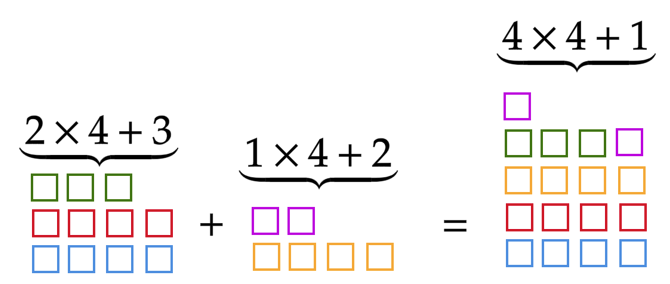Problems
Alice sums \(n\) consecutive numbers, not necessarily starting from \(1\), where \(n\) is a multiple of four. An example of such a sum is \(5+6+7+8\). Can this sum ever be odd?
Show that the difference between two consecutive square numbers is always odd.
One of the most powerful ideas in mathematics is that we can use letters — like \(a, b, n\) or \(x\) — to stand for numbers, shapes or other things. When we do this, we can reason about all such possible objects at once, without knowing exactly which number or shape we are really dealing with.
For example, the statement \[\text{``Let } a,b \text{ be numbers. Then } a+b=b+a."\] is true no matter what numbers \(a\) and \(b\) are. It tells us all of the following at the same time: \[3+5=5+3, \qquad (-10)+(-2)=(-2)+(-10), \qquad 7+0=0+7,\] and many more.
The rule \(a+b=b+a\) does not depend on the “three-ness” of \(3\) or the “five-ness” of \(5\) — it works for any numbers. Of course, we could not let \(a\) be a triangle and \(b\) be a tiger, because we do not know what it means to add a triangle to a tiger! Our rules only apply to objects for which the operations make sense.
This way of using symbols to express rules and patterns is what we call algebra. As long as we follow the rules that numbers follow, our reasoning will stay true. Today we will practise using these symbols to work with the algebra of numbers — it may take effort, but it is an important skill that will help you a lot in your mathematical journey.
Let \(n\) be a natural number and \(x=2n^2+n\). Prove that the sum of the square of the \(n+1\) consecutive integers starting at \(x\) is the sum of the square of the \(n\) consecutive integers starting at \(x+n+1\).
For example, when \(n=2\), we have \(10^2+11^2+12^2=13^2+14^2\)!
Find the contrapositive of the statement: “If in every school there is a class with at least \(20\) students, then there is a school with at least \(10\) students".
Show that if \(a\) and \(b\) are numbers, then \(a^2-b^2=(a-b)\times (a+b)\).
One of the most important tools in maths is the Pigeonhole Principle.
You may have already met it before, but if not, let’s recap it quickly.
Simply put: the Pigeonhole Principle states that if you have \(n\) pigeons (or objects) that you want to
place into a number of pigeonholes (or containers) that is strictly
smaller than \(n\), e.g: \(10\) pigeons but only \(9\) pigeonholes, then there will be a
pigeonhole with at least two pigeons. Why is this true? Imagine that
every pigeonhole had at most one pigeon. Since we have \(9\) pigenholes in total, there would be at
most \(9\) pigeons, not \(10\), as we are told. Today we will see how
this principle can be used to solve problems about numbers and their
divisibility properties.
Before we get started, we need to recap a very important concept: if we
have two numbers, say \(a\) and \(b\), we can divide \(a\) by \(b\), and we will obtain a quotient
\(q\) and a remainder \(r\), and write \[a=q\times b + r\] for example: if we
divide \(9\) by \(4\), we can write \(9=2\times 4 + 1\), i.e: the quotient will
be \(2\) and the remainder will be
\(1\). A final key fact that we need to
recap is the following: imagine we want to divide two numbers, for
example \(11\) and \(6\) by the same number, say \(4\). We can write \[11=2\times 4 + 3\qquad \text{and}\qquad 6=1\times
4 + 2\] So we can imagine \(11\)
as two packs of \(4\) little squares
and \(3\) “left over" squares, and
\(6\) as one pack of four little
squares with \(2\) left over squares.
We can combine these \(5\) “left over"
squares into one new pack of four, with now one “left" over square. With
this way of thinking, we see that the remainder of a sum of two
numbers \(a\) and \(b\) is precisely the remainder of the
sum of the remainder of \(a\) plus
the remainder of \(b\).

A final remark: in today’s sheet, when we say positive whole numbers, or natural numbers, we will mean the numbers \(1,2,\cdots\)
Show that given any three numbers, at least two of them will have the same parity. Recall that the parity of a number is whether it is odd or even.
Show that given any \(6\) whole numbers - not necessarily consecutive - at least two of them will have the same remainder when divided by \(5\).
Show that given any \(3\) numbers, there will be two of them so that their difference is an even number.